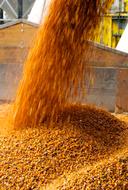The USDA recently released its Grain Crushings and Co-Products Production Report for March, reporting that corn use for fuel ethanol production in January 2025 was up 4% when compared to the same month of 2024.
UNICA, the Brazilian sugarcane industry association, has released data showing sugarcane processing continued to trend lower in late February. Corn ethanol production and ethanol sales, however, continued to grow during the two-week period.
ACE on March 18 provided feedback on the USDA’s technical guidelines for quantifying, reporting, and verifying GHG emissions associated with agricultural production of biofuel feedstock and the Department’s Feedstock Carbon Intensity Calculator.
The Renewable Fuels Association on March 18 submitted formal comments to the USDA’s Office of Energy and Environmental Policy regarding the interim rule on Technical Guidelines for Climate-Smart Agriculture Crops Used as Biofuel Feedstocks.
Growth Energy on March 17 shared recommendations with the USDA on how to improve and implement interim guidelines on climate-smart agriculture (CSA) practices. The agency is currently reviewing its interim rule on CSA crops used as biofuel feedstock.
Preliminary agenda announced for 2025 International Fuel Ethanol Workshop & Expo
Ethanol Producer Magazine announced this week the preliminary agenda for the 2025 International Fuel Ethanol Workshop & Expo (FEW) taking place June 9-11, 2025 at the CHI Health Center in Omaha, Nebraska.
The USDA maintained its forecast for 2024-’25 corn use in ethanol in its latest World Agricultural Supply and Demand Estimates report, released March 11. The outlook for season-average corn price was also unchanged.
The Nebraska ethanol and co-products industry remains a significant and stable force that contributes billions of dollars to the state’s economy, according to a new study from the University of Nebraska–Lincoln.
The American Coalition for Ethanol provides an update of its Regional Conservation Partnership Program, which aims to help ethanol producers and farmers unlock new markets and profit opportunities through soil health practices.
The current issue is Ethanol Producer Magazine focuses on the joint pursuit of higher value products in the context of lower carbon intensity production.
Certain ethanol producers rely on it, commodity organizations fight for it, and researchers tout its potential.
Various technology providers offer data solutions for farmers looking to implement low-CI practices as new monetary rewards incentivize their feedstocks.
UNICA, the Brazilian sugarcane industry association, has released data showing corn ethanol production continued to trend higher during the first half of February, accounting for nearly 96% of total ethanol production during the period.
Biomass Magazine has announced the six companies selected to pitch to a group of angel investors and venture capital firms at the International Biomass Conference & Expo, taking place March 18-20, 2025, in Atlanta, Georgia.
U.S. operable biofuels capacity held steady in December, with no changes for ethanol, biodiesel or renewable diesel, according to data released by the U.S. EIA on Feb. 28. Feedstock consumption was up slightly from the previous month.
The USDA on Feb. 27 released its Grains and Oilseed Outlook for 2025, predicting the 2025-’26 corn crop will reach a record 15.585 billion bushels, up approximately 5% when compared to the previous year.
The General Court of the European Union on Feb. 27 dismissed a challenge against the ReFuelEU Aviation regulations brought by European biofuel producers last year regarding regulation’s exclusion of crop-based fuels.
The USDA recently released its Grain Crushings and Co-Products Production report for February, reporting that corn use for fuel ethanol production in December was up slightly from the previous month, but down 2% when compared to December 2023.
CoBank is predicting U.S. corn planted acreage will reach 94.55 million this year, up 4.2% when compared to 2024. Sorghum planted acres are expected to fall 9.5%, according to the CoBank’s spring acreage outlook, released Feb. 20.
UNICA, the Brazilian sugarcane industry association, has reported that ethanol production was up during the second half of January with more than 96% of production coming from corn. Ethanol sales were also up for the full month.
The USDA maintained its forecast for 2024-’25 corn use in ethanol in its latest World Agricultural Supply and Demand Estimates report, released Feb. 11. The outlook for corn prices, however, was increased.
In January, the USGC and the NCGA jointly held the 1st Corn Sustainability Strategy Session to discuss the U.S. corn industry’s plans to leverage its sustainable practices and respond to market requirements across domestic and global supply chains.
The March issue of Ethanol Producer Magazine focuses on low-carbon feedstock production, plant improvement projects, and New Energy Blue's cellulosic project.
Scoular is the new formalized supplier of grain and logistics to Mid America Agri Products/Wheatland’s ethanol plant in southwestern Nebraska. Scoular operates an extensive origination network in western Nebraska.
The California Air Resources Board has approved point-of-origin feedstock tracking requirements for crop-based biofuels, adding appeal to emerging traceability technologies and programs.
Verity and Landus announce agreement to track and verify sustainable agriculture attributes at soybean facility
Verity Holdings LLC, a subsidiary of Gevo Inc., and Landus have announced a new agreement aimed at unlocking added value for farmers through sustainability premiums via export markets.
New markets, export opportunities and policy changes are all things that will help build demand, said IRFA Executive Director Monte Shaw at the Iowa Renewable Fuels Summit. The nearest term demand driver should be year-round E15, he added.
U.S. operatable biofuel production capacity was unchanged in November 2024, according to data released by the U.S. EIA on Jan. 31. Feedstock consumption was up from both the previous month and November 2023.
The U.S. Department of Energy Bioenergy Technologies Office released the Feedstock-Conversion Interface Consortium Capstone Report. The report summarizes the FCIC’s goals, research activities, and achievements over the past three years.
The USDA recently released its Grain Crushings and Co-Products Production report for January, reporting that corn use for fuel ethanol production in November 20024 was up 2% when compared to the same month of 2023.
Advertisement
























